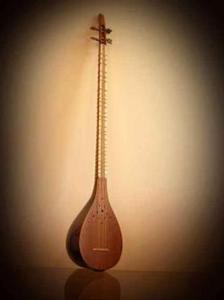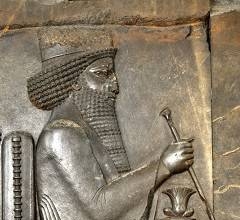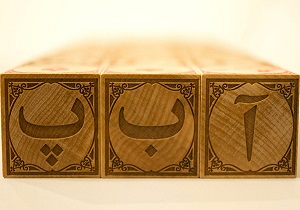Three-string historical instrument
 Setar From Percussion instruments of Iranian music Is
Setar From Percussion instruments of Iranian music Is
which is usually not played with a mallet and is hit with a nail.
three-string and similar instruments such as two-string, tanbur and chagur
It has been popular in the central regions of Asia and the Middle East.
It seems that Setar has been popular since the 4th century.
History
Three strings in the past three strings (the wire) had and now has four wires
whose third and fourth strings are close to each other and are played at the same time
Ando's set is usually called "Bam" wire.
Over time, those like
Abu Nasr Farabi, Abu Ali Sina, Safi al-Din Ermoi, and among the late Abul Hasan Khan Saba
He understood the need to add one more string to this instrument, and today's three strings are four strings
(Historically, this string is the fourth string, but it is called the third string).
The third string of three strings is known as Mushtaq string
And according to a narration by Abul Hasan Saba
This string was first added to this instrument by a dervish named Mushtaq Alisha.
Some, including some mystics, also call it "Avatar"..
Ingredients
The three-string instrument has two parts: bowl and handle. At the end of the handle is the claw, which is where the phones are placed.
Specifications of Setar
- Phone case or case
- the phones
- The curtain before Satanak
- Satanic
- Main curtains (four layers)
- Side curtains (three layers)
- Category
- Bowl
- Page
- the vault
- Wire catcher
- the wires
the wires
Three strings have four wires as follows:
- The first wire or white steel wire
- The second wire or yellow wire of bronze
- The third wire or Mushtaq wire or bell which is exactly the same type and size as the first wire
- The fourth wire is yellow and thicker than the other wires.
Bowl
In terms of structure, the three-string bowl is similar to the oud or tanbur bowl, but it is smaller than them.. The length of the three-stringed bowl is from 26 to 30 cm, its width is between 12 and 16 cm, and its depth is about 13 cm, and it is usually made of mulberry wood..
Page
The top of the three-stringed bowl is covered with a thin board of wood, which is called a plate. The plate has holes for the sound to come out and the musician's right hand is placed on it.
Category
The length of the handle is 40 to 48 cm, the part where the phones are installed is 12 cm, and the width of the handle is 3 cm..
the vault

The vault is a movable piece that is located on the board and at a distance of four fingers from the end of the bowl. The width of the trestle vault is between 5 and 6 cm and its height is less than 1 cm, and it is made of wood.. After passing through the vault, the wires pass through the handle and reach the phones by Shaitanak.
Wire catcher
The wire holder is located at the end of the bowl maker and is made of wood. The wire holder is used to store the wires.
Satanic
The devil is placed between the main part of the handle and the instrument's claw, and its material is made of bone or plastic. Satanak is used to guide and divide the wires in the upper part of the handle.
Smartphone
On one side, the wire is tied to the wire holder at the end of the bowl and on the other side to the tuning forks at the end of the instrument.. The instrument can be tuned by rotating the handsets.
curtain
Curtains are thin threads made of animal intestines or silk, which are tied in three or four layers across the width of the three strings and are responsible for dividing musical intervals.. The number of curtains is 26, and one of them is closed before the shaitanak, and its distance from the shaitanak is effective in the sound of three strings..
Voice
Three strings have a velvety and delicate sound, since it is played with the nail of the index finger of the right hand, the sound of the instrument has a direct connection with the nerves and psyche of the musician, and therefore three strings are often called the companion of lonely times..
Most of the listeners feel that the three-stringed instrument has a sad tone and sound, but the contemporary musicians of Iranian music, in an effort to develop modern and new Iranian music, have created beautiful works that are completely different from the atmosphere that was imagined for this instrument two decades ago. Is.
cook
All four strings can be tuned by the handsets built into the end of the handle.
The base note of the three-string tuning is usually the second note for the first string, and the rest of the strings are tuned based on the first string.. A double note used in three strings, middle C in piano (Middle C) Is. Note two in Iranian music is usually one step lower than note two in classical music, and is equal to C flat in the range.. [۱]
Sometimes, for practice, the Net La base is used to tune the first string, because the sound of the instrument is lower and does not bother the player's ears.. Another reason for using net-e-la is that the wires are looser, and as a result, the wire is less damaged and its useful life increases; At the same time, it is easier to perform techniques such as micro-marab on loose wire.
Usually, a specific tuning is considered for each device, but depending on the device, the feeling of the musician and the theme of the desired song can be different.. Changing the tuning of each instrument and song in Iranian music leads to a change in the mood of the songs, but it is possible to play songs related to another instrument or song by using the tuning of different instruments and songs..
Different tuning modes
The naming of strings for tuning is conventional. This means that the tuning of the string does not have to be the same note of the range. For example, in the case where the first string is to be tuned on the note D and the second string on the note C, both can be brought down one fret and the first string is tuned on the note Cb and the second string is tuned on the note F..
| Wire 1 | Wire 2 | Wire 3 | Wire 4 | ||
|---|---|---|---|---|---|
| Tiny sound with stiff and stretched strings | two | one hundred | two | two | |
| The strings should be tuned two semitones lower | Sibemal | Fa | Sibemal | Sibemal | |
| The strings should be tuned three semitones lower | no | may | no | no |
Due to the lower note of two in traditional Iranian music compared to classical music, the tune of "C-flat, F, C-flat, C-flat" is known as "D, C, D, D". In fact, the naming of this tune ( which is a familiar tune here) As "two, cell, two, two" is for the convenience of musicians and students to understand the ratio of the distance between the note used in the first string and the second string, which is 5 semitones..
Kook Mahor
The three-string tuning is known as the base in the Mahor instrument, and in this tuning, the three-string has its greatest sound range..
Three strings are tuned in this way to play the instrument:
| Wire 1 | Wire 2 | Wire 3 | Wire 4 | |
|---|---|---|---|---|
| Mahor Do | two | one hundred | two | two |
| … | two | Fa | two | two |
| … | two | one hundred | two | Fa |
Kook Shur
The three-string tuning in the Shur instrument is the same as the Mahor instrument, with the difference that the fourth string is tuned five frets instead of the second note and is tuned to the F note..
This is how three strings are tuned in the salt machine:
- From the first to the fourth wire in order:
- two
- one hundred
- two
- Fa
Salt belongings
The songs of Abu Ata, Bayat Turk, Afshari, Dashti, and Bayat Kurd, although they belong to the Shur device, but each one has a separate tune..
(From the first to the fourth wire in order)
Abu Ata's song
- two
- one hundred
- R
- R
The song of Bayat Turk
The tune of the three-string in Bayat Turk's song according to Ahmed Ebadi, the three-string player, is like this:
| name | first wire | second wire | third wire | fourth wire | |
|---|---|---|---|---|---|
| Bayat Turk CBM | two | Fa | Sibemal | Sibemal | |
| Right-handed CBM | two | one hundred | Sibemal | Fa | |
| Bayat Turk two | two | one hundred | two | two | |
| It leaves a stalemate | two | Fa | fills | fills | |
| Byat Turk Fa | two | Fa | two | two |
Afshari song
- two
- one hundred
- two
- two
Plains song
- two
- one hundred
- no
- R
Cook Homayun
The tuning used for Humayun's device is exactly the same as the tuning used in Abu Atta's song. The same tune is also used for three strings in the playing of Isfahan Bayat.
String musicians
- Former musicians:
Mirza Abdullah, Darwish Khan, Abolhasan Saba, Ahmed Ebadi, Noor Ali Borumand, Yusuf Fortun, Saeed Hormozi, Dariush Safwat, Abdullah Dadour, Mahmoud Tajbakhsh.
- Current musicians:
Jalal Zulfonun, Mohammad Reza Lotfi, Hossein Alizadeh, Dariush Pir Niakan, Ata Janguk, Dariush Talai, Keyvan Saket, Masoud Shaari, Hamid Motabsem, Kayhan Kalhor, Mohammad Firouzi, Kia Tabasian, Amir Hossein Pourjavadi, Ghazaz Kamkar,







Your very useful and useful website has helped me a lot.
From the beginning, knowing names has been a factor until the end.
thank you
درود
I am glad that it brought your satisfaction